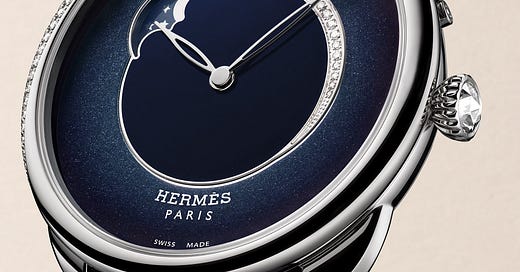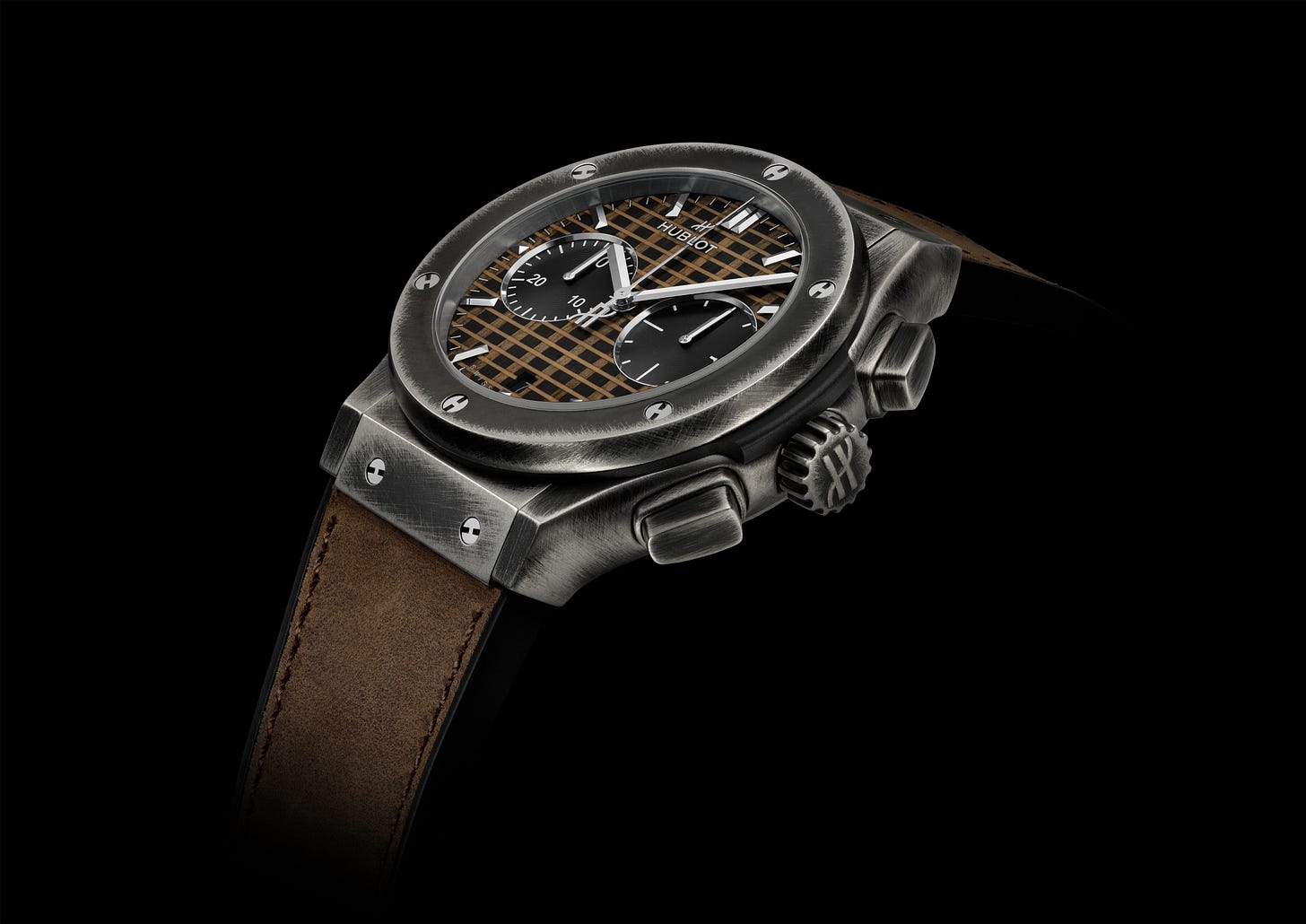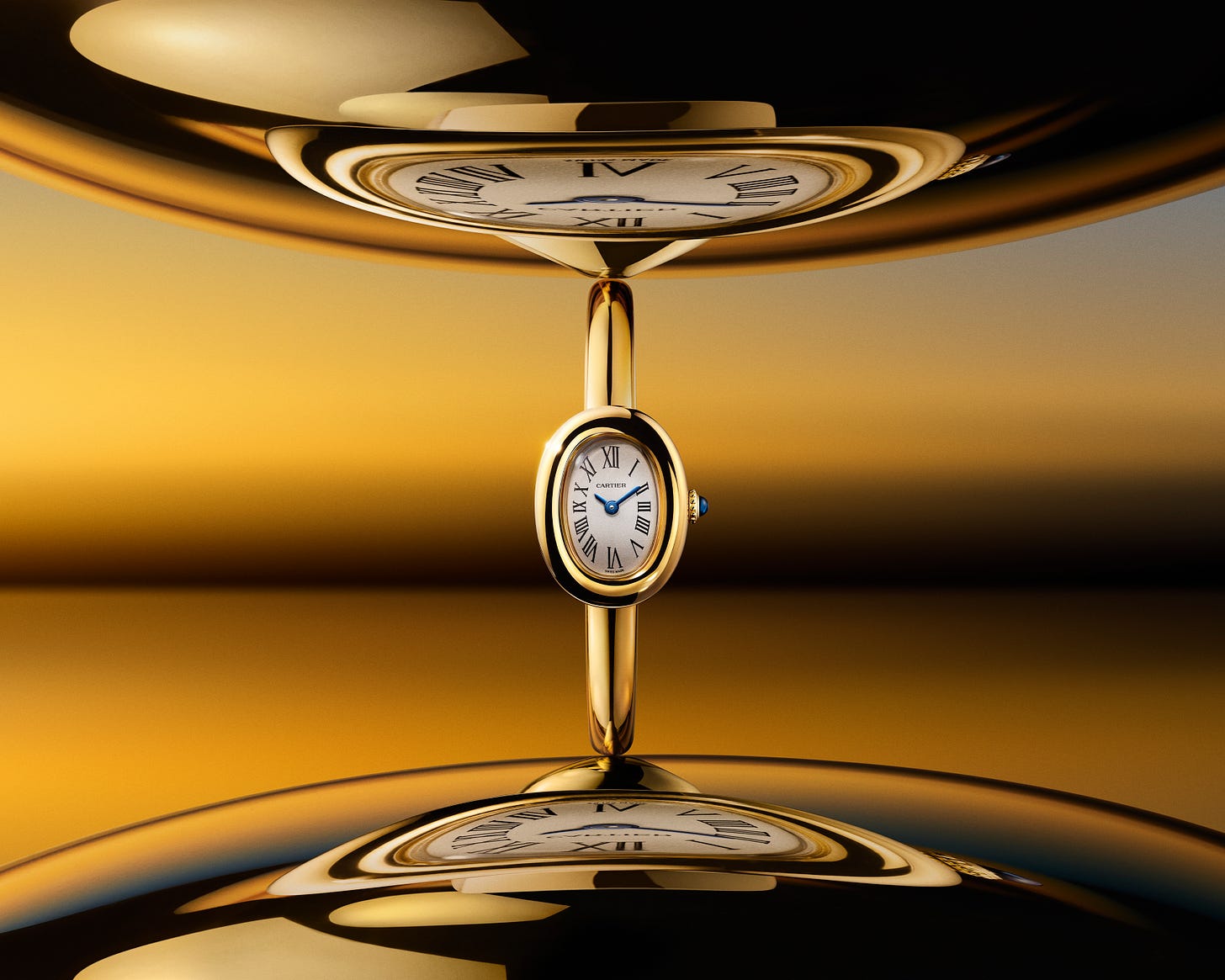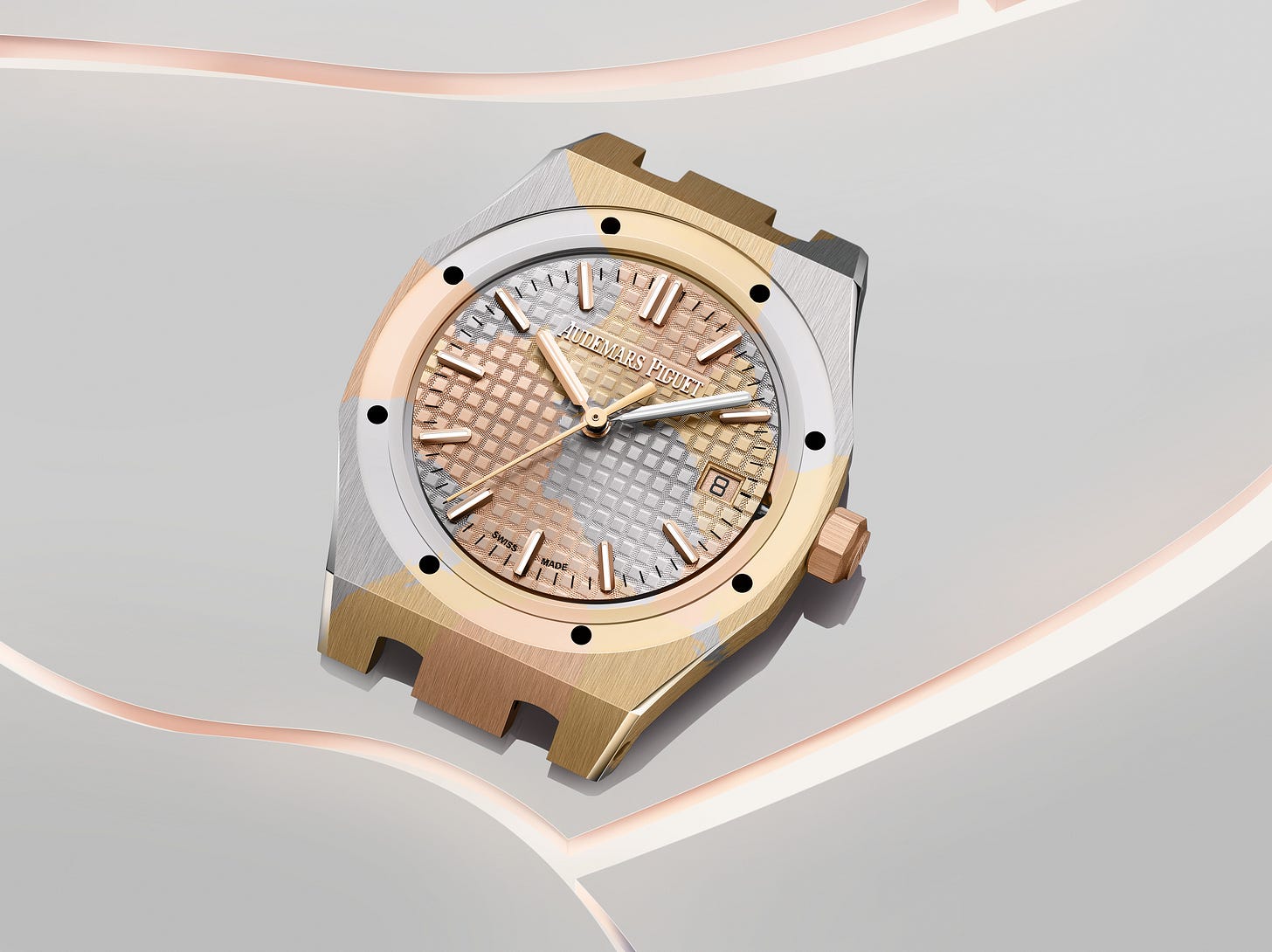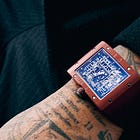Timeless Innovation: How Heritage and Technology Shape Modern Watchmaking
This week on WorldTempus: Hermès Arceau Petite Lune, Hublot in Lucerne, Montblanc on AI, the legacy of the Type XX & Cartier Tank, plus a focus on watch bracelets and materials.
THIS WEEK’S NEW
Arceau Petite Lune: A Celestial Dance on the Wrist
Hermès invites us on a journey beyond time with the Arceau Petite Lune, a watch that captures the brand’s whimsical yet sophisticated approach to horology. While timekeeping is taken seriously, Hermès infuses it with poetry and a touch of mischief. This latest creation allows the moon and stars to drift across the wrist, offering a stunning blend of watchmaking expertise and artistic craftsmanship.
Designed in 1978 by Henri d’Origny, the Arceau remains a symbol of Hermès’ equestrian heritage. The Petite Lune retains its signature round case with asymmetrical stirrup-shaped lugs, now enhanced by an elegant 38 mm stainless steel case. A refined gem-setting adds subtle brilliance, with 99 diamonds discreetly adorning the upper bezel and a rose-cut diamond set into the crown. Hermès proves that sophistication does not always mean restraint—sometimes, a touch of sparkle is just what is needed.
The dial is a masterpiece of color and depth. A gradient of blues, from twilight to deep midnight, creates a mesmerizing visual effect, drawing the eye to the center of the watch. An arc of 15 diamonds adds a celestial shimmer, enhancing the moon phase complication positioned between 10 and 11 o’clock. Here, the moon and stars perform an ever-changing ballet, appearing and disappearing as time flows. Two slender, openworked hands complete this dreamlike composition.
Beneath this elegant display, the self-winding H1837 caliber powers the Arceau Petite Lune with a 42-hour power reserve. A transparent sapphire caseback reveals the movement’s meticulous finishing, including pearled and snailed decorations, with the Hermès “H” motif gracing the bridges and oscillating weight.
Staying true to its leatherworking roots, Hermès equips the Arceau Petite Lune with an alligator strap crafted in-house, perfectly matching the dial’s shades. The interchangeable design allows wearers to adapt their timepiece to their style, mood, or occasion.
With this creation, Hermès continues to challenge conventions, offering not just a timepiece but an invitation to escape into a world of imagination.
A Timepiece That Captures the Spirit of Lucerne
Hublot unveils a remarkable new addition to its Classic Fusion collection: the Classic Fusion Chronograph Boutique Lucerne. This exclusive timepiece pays tribute to Lucerne’s historic Kapellbrücke (Chapel Bridge), an emblem of Swiss heritage and resilience. Available only at Hublot Boutiques in Lucerne, Zurich, Zermatt, and Geneva, the watch merges artistic craftsmanship with a deep appreciation for Swiss history.
The Chapel Bridge, built in the 14th century, is the oldest covered wooden bridge in Europe and a treasured symbol of Lucerne’s past. Known for its triangular paintings and distinctive wooden architecture, it has inspired generations with its tales of love and endurance. Following the devastating fire of August 1993, which destroyed a significant portion of the structure, the bridge became a powerful representation of both loss and renewal. Launched on Valentine’s Day, this special edition chronograph reflects Hublot’s admiration for Lucerne, celebrating the bridge’s emotional significance and timeless beauty.
The dial design is one of the most striking elements of this timepiece. It features a wood marquetry motif, meticulously inlaid on a carbon plate, mirroring the bridge’s intricate wooden structure. In an exceptional tribute to history, the marquetry is crafted from actual burned wood recovered from the 1993 fire, ensuring that each watch contains an authentic piece of Lucerne’s cultural fabric.
Further enhancing its exclusivity, the case back bears the engraving “Special Edition Lucerne Boutique”, alongside a finely detailed metallic depiction of the Chapel Bridge. Encased in a 45mm brushed titanium case, the watch is lightweight yet durable, complemented by a brushed blackened aged titanium bezel secured with Hublot’s signature six H-shaped screws. The timepiece is completed with a vintage-inspired brown leather strap, adding a classic touch to its contemporary design.
Beyond aesthetics, this watch represents Hublot’s commitment to preserving Lucerne’s heritage, as the brand actively contributes to the maintenance of the Chapel Bridge. The Classic Fusion Chronograph Boutique Lucerne is more than a timepiece—it is a lasting tribute to Swiss craftsmanship, culture, and history.
Watch Knowledge
Is AI Changing the Way We Perceive Watchmaking?
Twenty years ago, people questioned Google. Today, they question Wikipedia. Tomorrow, will it be ChatGPT? In an intriguing experiment, AI-generated insights about watch brands were presented to industry leaders for their reactions. Laurent Lecamp, General Manager of Montblanc Watches, was among those who engaged with the results.
ChatGPT provided a detailed summary of Lecamp’s background, from his education at Neoma Business School to his experience at LVMH, Cyrus Watches, and Carl F. Bucherer. Lecamp was impressed, stating, “Yes, that is all accurate. I am surprised by the level of precision!” However, he added further details about his work as a lecturer and his passion for extreme marathons, mentioning his past races in Lake Baikal and Antarctica, with a third one planned in Yakutsk, Russia.
When discussing Montblanc, ChatGPT highlighted the brand’s strengths: craftsmanship through Minerva, innovative designs, and technical achievements such as the 1858 Geosphere 0 Oxygen. Lecamp agreed, emphasizing that their Iced Sea 0 Oxygen collection offers real innovation in the mid-range segment.
Regarding competition, AI compared Montblanc to Longines, TAG Heuer, and Tudor, which have deeper watchmaking heritage. Lecamp responded, “I couldn’t have said it better myself!” On pricing, ChatGPT provided a breakdown from entry-level to high-end, citing the TimeWriter II Chronograph Bi-Frequency 1000 at approximately €230,000. Lecamp clarified that Montblanc discontinued watches below €2,000 to focus on mid-range and higher-end models, with Minerva Haute Horlogerie pieces starting at €30,000.
AI also noted Montblanc’s challenge in establishing a strong watchmaking identity due to its legacy in luxury pens. Lecamp countered that the brand’s watchmaking journey began in 1997, gaining legitimacy through the acquisition of Minerva in 2007. The Nicolas Rieussec Chronograph and the ExoTourbillon solidified Montblanc’s place in haute horlogerie.
On the topic of resale value, ChatGPT suggested that Montblanc watches tend to depreciate. Lecamp refuted this, citing a 2024 Morgan Stanley study listing Montblanc among the few brands with stable or increasing resale value. He pointed to the strong performance of models like the Iced Sea in the secondary market.
Finally, when AI mentioned that Montblanc watches are available in boutiques, authorized retailers, and online platforms like Chrono24, Lecamp clarified that the brand has no agreements with resale sites, recommending official boutiques or authorized sellers for the best customer experience.
This experiment revealed that while AI can provide a well-informed perspective, nuances, strategic decisions, and brand positioning still require human insight.
How Did the Cartier Tank Become a Century-Long Icon?
In 1917, amid the turmoil of World War I, Louis Cartier found inspiration in an unexpected place—the armored FT-17 tanks used by the Allies. Observing their robust yet streamlined design, he envisioned a timepiece that would embody both strength and elegance. The result was the Cartier Tank, a watch that has since become one of the most recognizable and enduring designs in horology.
Breaking away from traditional round cases, the Tank introduced a geometric form that hovered between a rectangle and a square. Its proportions followed the Golden Ratio, ensuring visual harmony. True to Cartier’s design philosophy, it adhered to four key principles: purity of line, precision of form, balanced proportions, and refined details. The watch’s elongated brancards mirrored the tracks of its namesake, while the dial evoked the armored hull. This minimalist yet powerful aesthetic aligned with the emerging Modern Style, later known as Art Deco.
When a handmade prototype was presented to General John Pershing, commander of the American Expeditionary Forces, he had no way of knowing that this watch would go on to achieve legendary status. The first six Tank models were officially sold in 1919, and by early 1920, they had all found eager buyers. From that moment, the Tank became an object of desire, worn by royalty, artists, and cultural icons. Lady Diana, Yves Saint Laurent, Andy Warhol, and Brad Pitt are just a few of the luminaries who have embraced its timeless design.
Over the decades, the Tank has evolved into a collection with multiple variations, including the Tank Chinoise (1921), Cintrée (1921), Américaine (1989), and Française (1996). Yet, despite these transformations, its essence remains unchanged—a refined and unmistakable symbol of elegance that has endured for over a century.
Comparative
The Timeless Influence of the Type XX Chronograph
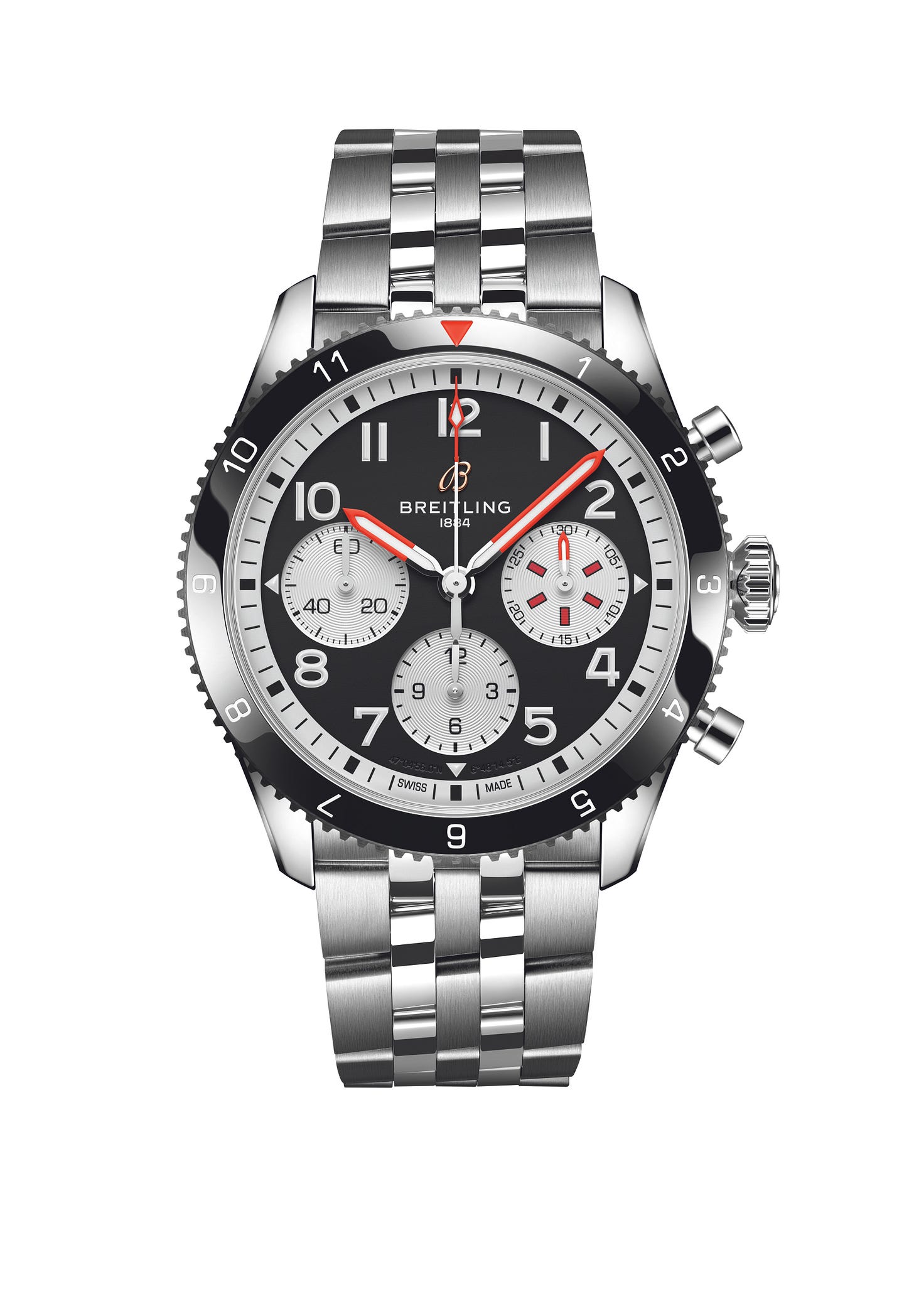
A true aviation icon, the Type XX chronograph has captivated pilots and watch enthusiasts alike since its inception in the mid-1950s. Originally designed for the French Ministry of Defense, this precision instrument quickly became a benchmark in military timepieces. Decades later, its vintage charm and technical reliability continue to inspire modern interpretations across various brands.
Hamilton pays tribute to the Type XX’s legacy with the Khaki Pilot Pioneer, a robust chronograph echoing the models supplied to the British Royal Air Force in the 1970s. Powered by a manual-winding movement, its 40mm steel case houses a dial designed for optimal legibility. Longines stays true to the original concept with its Spirit Flyback, incorporating a flyback function for seamless timekeeping. The matte green dial, framed by a bi-directional ceramic bezel with a yellow gold cap, enhances its distinctive aesthetic.
Breitling revives the spirit of aviation with the Classic AVI Mustang, a modern reissue of the 1953 Ref. 765 AVI Co-Pilot. This 42mm steel chronograph retains its practical 12-hour rotating bezel, ensuring functionality remains paramount. Meanwhile, Bell & Ross takes a bold approach by reinterpreting the Type XX with the BR 01-94. Its 46mm square steel case, inspired by cockpit instruments, emphasizes readability and durability—essential qualities for pilots.
IWC introduces additional complications to its Pilot’s Watch, featuring a chronograph movement with day and date displays. Encased in a 41mm steel case with a deep blue dial, this timepiece offers versatility beyond aviation. Chopard, on the other hand, fuses motorsport influences into the Mille Miglia Classic. Crafted in Lucent Steel™, its case is both brighter and more resilient than standard stainless steel, complemented by a tire-tread rubber strap.
At the higher end, Blancpain’s Air Command combines titanium and ceramic materials with an in-house flyback chronograph movement, while Breguet—the brand synonymous with the Type XX—unveils a gold-cased civilian edition featuring a ceramic bezel and the legendary flyback function. These timepieces uphold the pioneering spirit of their predecessor, proving that the Type XX’s influence remains as strong as ever.
Beyond Function: How Watch Bracelets Elevate Timepieces
A watch is more than just its dial and movement—the bracelet plays a crucial role in both style and functionality. Four remarkable examples illustrate how brands are pushing the boundaries of design and innovation.
Blancpain’s Bathyscaphe collection introduces an all-ceramic bracelet, a technical achievement that took three years to develop. This high-tech material is 25% lighter than steel but five times harder, ensuring durability without compromising comfort. Its patented cam-shaped pin system prevents the links from touching, eliminating the risk of breakage. The deep black finish, enhanced by exceptional polishing, creates an interplay of light that enhances the watch’s bold, sporty character.
Cartier redefines versatility with the Baignoire, a watch known for its distinctive oval shape since 1973. The latest version features a yellow gold bangle bracelet, allowing it to transition seamlessly from a timepiece to a jewelry cuff. Worn with the dial visible during the day, it transforms into a sleek accessory at night when turned inward. This fusion of elegance and practicality is further amplified when stacked with Cartier’s iconic Juste un Clou or Love bracelets.
Patek Philippe revives the tradition of chain-style metal bracelets with the Golden Ellipse reference 5738/1R-001. Crafted from rose gold and developed over 15 years, this hand-polished bracelet comprises 363 individual components, over 300 of which are meticulously assembled by hand. The patented design ensures flexibility while allowing easy adjustments, complemented by a three-position clasp for a tailored fit. This nod to the brand’s late 1960s and 70s designs adds a timeless appeal.
Vacheron Constantin’s Overseas, launched in 1996, was ahead of its time with its interchangeable strap system. Delivered with three options—an integrated metal bracelet, a leather strap, and a rubber alternative—the watch adapts effortlessly to any setting. The metal bracelet features a triple-blade folding clasp that expands by up to four millimeters for added comfort. This pioneering approach makes the Overseas as suitable for a sports field as it is for a formal occasion.
These examples demonstrate that a watch bracelet is more than an attachment—it is an essential element that enhances both function and aesthetics.
Collector’s corner
Audemars Piguet Redefines Materials in Watchmaking
Since 1875, Audemars Piguet has continuously reimagined watchmaking through bold design, technical mastery, and groundbreaking materials. The past year has been no exception, with the introduction of innovative materials such as Frosted Gold, Sand Gold, Chroma Gold, and colored forged carbon, each redefining the boundaries of traditional craftsmanship.
Frosted Gold, first introduced in 2016 through a collaboration with Italian jeweler Carolina Bucci, creates a shimmering effect reminiscent of diamond dust. In 2024, this distinctive finish appears on two 34mm Royal Oak Selfwinding models in white gold and yellow gold. Enhancing the brilliance, their dials feature a unique Crystal Sand finish, evoking the sparkle of ruthenium crystals. With alternating hammered and satin-brushed surfaces on the case and bracelet, these watches play beautifully with light.
Sand Gold, unveiled in March 2023, brought a fresh perspective to the Royal Oak Selfwinding Flying Tourbillon Openworked (41mm). This exclusive alloy, a blend of gold, palladium, and copper, shifts between rose and white gold tones, evoking sunlit sand dunes. Not only aesthetically striking, Sand Gold is also highly resistant to fading. This material was later used in the automatic [RE]Master02, a contemporary interpretation of a 1960s model, featuring an asymmetrical Sand Gold case.
Last spring, Audemars Piguet stunned the watch world with Chroma Gold, a polychrome gold prototype in a 34mm Royal Oak. Created by sintering yellow, rose, and white gold powders into a camouflage pattern, this innovation represents a new chapter in material exploration. “This multi-colored gold opens a new chapter in exploring precious materials to offer unprecedented design to both our creations and our clients,” stated Lucas Raggi, Research and Development Director at Audemars Piguet.
Pioneering the use of forged carbon since 2007, the brand elevated this material further with a striking two-tone aesthetic for the 43mm Royal Oak Concept Split-Seconds Chronograph GMT Large Date. Featuring black and blue hues, this futuristic design incorporates luminescent blue pigments into the carbon fiber caseband, ensuring visibility even in the dark.
Remaining true to its iconic style while embracing innovation, Audemars Piguet continues to push the limits of horology. With 2025 marking its 150th anniversary, the brand’s commitment to exploration and craftsmanship remains stronger than ever.


